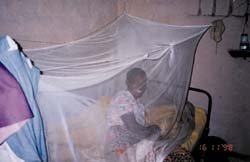Official Development Assistance (ODA)
14. An Anti-Malaria Program for Improvements in the Health of Zambian Children
Malaria is an infectious parasitic disease transmitted by mosquitoes. When a carrier mosquito bites a human and begins sucking blood, it causes infection in its human host by injecting saliva that contains the malarial parasite. Symptoms develop after a period of incubation lasting several days, and typically include fever, chills, and nausea. By WHO estimates, as many as 300-500 million people worldwide are infected by malaria every year, and between 1.5 and 2.7 million die of the disease, including about 1 million children under the age of five.
In Zambia, as in many other African countries, malaria ranks as one of the most serious of public health problems. In 1995, the morbidity rate for malaria stood at 288 per 1,000 individuals. Also, as hospital statistics bear out, children under age five account for roughly half of all malaria patients who are hospitalized or who die of the disease. Clearly, malaria has been taking an exceptionally heavy toll on the health of infant children.
In view of the impact that malaria has on the health of Zambian citizens and the threat it poses as a bottleneck to economic progress, the Zambian government has been working with the cooperation of USAID (Agency for International Development), UNICEF, and the WHO to conduct studies necessary for the establishment of anti-malaria programs that are well-adapted to the Zambian setting.
To help the Zambian government mount an effective anti-malaria campaign, Japan and other leading donor countries and institutions decided to explore avenues for collaboration through negotiations at the local level and furnish aid for programs in the priority districts of Chipata, Lundazi, and Chama in the Eastern Province, Kitwe District in Copperbelt Province, and Samfya District in the Luapula Province. To strengthen and expand anti-malaria programs in these priority areas, in March 1999 Japan decided to supply the Zambian government with pesticide-treated mosquito nets, malaria drugs, and medical equipment for the diagnosis and treatment of malaria. The mosquito nets supplied by Japan were to be distributed with USAID financing and technical assistance to citizens in the three eastern state districts. In parallel with the Japanese aid, USAID-led programs have been implemented in Kitwe to develop water drainage infrastructure and convert swampland areas that serve as breeding grounds for malarial mosquito species. Also, UNICEF has teamed up with the local health council in Samfya for educational campaigns that are designed to improve public awareness of malaria countermeasures.
It is anticipated that these efforts will help malaria-prevalent areas of Zambia establish sustainable malaria prevention systems and thereby foster improvements in the health of Zambia's children.


Citizen using a mosquito net distributed with UNICEF financing (in the Samfya district of Luapula Province).
